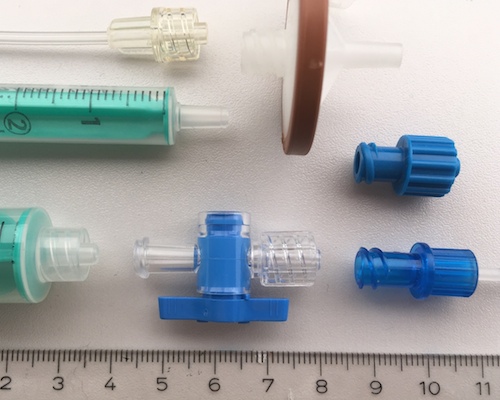|
There
are two luer adapters: One is called luer slip, which is
just a cone. The
luer lock adapter has a 6% cone or a 3.44° opening
angle.
figure
1: different luer slip and luer lock adapters.
pointing right - male side. pointing left - female side male
piece - luer slip The
luer cone is max. 7.5 mm long, it is typically 4mm at
the tip it is 4.45 mm at the end The
ID of the luer cone does not seem to be specified (this
is why there is no number in the drawing below). The
opening is typically about 2 mm and as far as we can see
the channel is typically not conical inside. Yet the
radius of the rounding at the tip of the cone is
specified to be max 0.5 mm male piece - luer lock  figure 2: male luer lock dimensions Concentric
with the luer cone, there is a cylindrical collar with
an internal thread (lower left on picture) The cylinder
might also be a loose cap like on the stopcock above
right side, so you can fix the luer lock without turning
the male piece itself. The cone is usually securely
fixed on the female piece with one full turn (5mm of
total length of 7.5mm) The ID of the cylinder body is 8mm and the opening between the threads is 7 mm (so threads are 0.5 mm high). The threads have a 30° shoulder and they are > 0.3mm at the top. The threads have a 2.5mm pitch and they start on both sides (180° offset) so one full turn moves 5 mm. The
luer taper sticks out of the luer lock thread by
typically 2 mm The OD of the locking cylinder is not defined. Our "Braun Injekt" luer lock syringes (see lower left on picture) typically have a flat cylindrical outer shape. The cylinder is 7mm long being slightly conical (9.8mm at the tip and 9.9mm at the syringe body). The loose luer lock cap with an internal thread of the stopcocks above has a structured outside shape with a max OD of 11mm. female
piece - luer slip the
female piece typically has an opening of 4.3mm and it is
9mm deep (so
there is enough room for the 7.5mm long cone).
With a 6% slope (or 3.44° opening angle) it should
be 3.76 mm at its end . female piece - luer lock  figure 3: female luer lock dimensions additionally
to the conical 4.3mm opening, there is a 2.5mm pitch
right hand thread on the outside of the piece. It starts
on both sides, so one full turn moves 5 mm. The width of
the thread is > 0.3mm at the top. Needles often have
a very short piece of outer thread (only 270° or
3.7mm) that is yet enough to secure it. (like the female
side of the stopcock on the picture) The OD of the thread on the female piece is 7.8 mm, the OD of the body is 6.7mm so the thread is 0.55mm high with 30° shoulders. REMARK:
A.Ravin:
A Luer slip with a rotating lock. J. Lab. Clin. Med.
(1952) 39(1): S. 168 PMID 14889106 Luer
connector standards are currently (ISO
80369-7) subject to change to avoid the
possibility of mixing up connectors for different media.
If this page helped you, you can help us by clicking on our latest research paper in nature geoscience It is on CO2 release from continental shelves and you can read it for free here The paper has
a wonderful graph
that shows the relation between CO2 and
sea-level during the last 800,000 years. |
